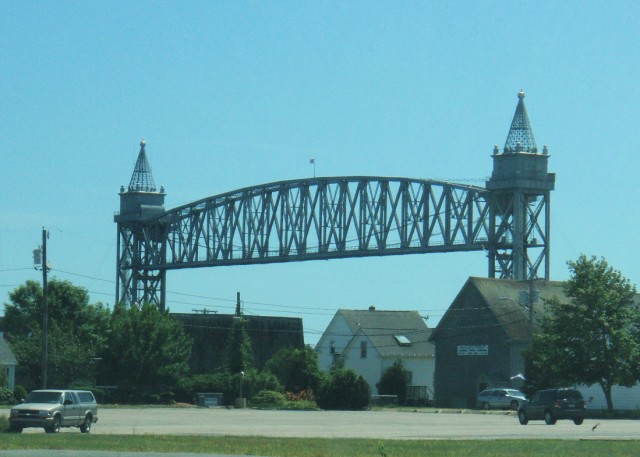
LONGEST - Verticle Lift Bridge Built by a Government Agency - Cape Cod Canal Railroad Bridge - Buzzard's Bay, MA
Posted by:  silverquill
silverquill
N 41° 44.594 W 070° 36.836
19T E 365799 N 4622526
Opened in 1935, this 544-foot span vertical lift bridge was built by the U.S. Army Corps of Engineers, the longest ever built by a U.S. Government Agency. It was financed under the New Deal, WPA and PWA projects.
Waymark Code: WM73V3
Location: Massachusetts, United States
Date Posted: 08/29/2009
Views: 8

From the
Cape Cod Railfans
The bridge was constructed from 1933 to 1935, and was completed in two stages. The first of these stages involved constructing the foundation or substructure. Hundreds of oak piles were driven into the ground, followed by two layers of concrete, and finished with granite channel piers. It was a complicated process, and as much work as possible was done by hand labor, to provide jobs during the depression. On January 4, 1935, the foundations were complete, and the steel workers began construction of the two towers that would carry the 544 foot movable span.
The Cape Cod Canal was actually closed for five days in September of 1935 while the middle sections of the span were completed. On the morning of December 29, 1935, a passenger train from Boston to Hyannis was the first train to cross the bridge.
The 544 foot span weighs 2,050 tons and provides 136 feet of vertical clearance when in the raised position at mean high water. The span is balanced at each end by a 1,000 ton counterweight. The span is raised and lowered by four 150 horsepower electric motors which take about 2 and a half minutes to fully lower and seat the span. An emergency generator is located on the North side of the bridge, in case of a power outage.
When a train needs to cross the bridge, they radio bridge control, who in turn contacts the marine traffic controller. The traffic controller must verify that there are no large vessels in, or approaching the canal before he can give bridge control permission to lower the span. He also must dispatch a patrol boat approximatly [sic] one half mile up current from the bridge to warn smaller boats that the bridge will be lowered (and if necessary the patrol boat can stop smaller boats, for when the bridge is lowered, there is only about 7 feet of clearance from the water).
Once the traffic controller has done this, he can give bridge control permission to lower the span. Bridge control then sounds two blasts of the bridge's horn, and then proceeds to lower the span. Once the bridge is fully lowered, and seated properly, he notifys [sic] the Buzzards Bay tower operator. The operator is in charge of the interlocking. The operator then throws a system of levers, which do a number of things, including: Lock the bridge in the lowered position and prohibit bridge control from attempting to raise the span; Position the turnout (Canal Junction) for either the Cape Main (to Hyannis and Yarmouth) or the Falmouth Branch; close the derail(s) necessary for train movement, and finally give the train an Approach signal.
Once the train is clear of the interlocking, this procedure is reversed. The operator turns all signals to Stop, puts all derails in the derailing position, and restores power to bridge control. Bridge control then proceeds to raise the span. Once locked in the fully raised position, bridge control sounds one blast of the bridge's horn, to signal marine traffic that the bridge is fully raised.

Some interesting history and photos from
Mt. Holyoke College
On March 31, 1928, Congress directed the U.S. Army Corps of Engineers to implement as series of improvements, including the replacement of the three bridges. The Corps selected two land areas that were naturally elevated in order to accommodate large sea going vessels. The vertical clearance was 135 feet, and a horizontal clearance of 480 feet. The existing railroad tracks made it impractical to relocate the railroad bridge. The Corps selected a vertical lift bridge design allowing for the same clearance as the highway bridges.
The Public Works Administration, the group responsible for managing Emergency Relief funds during the Great Depression, authorized the construction of the three bridges on September 6, 1933. The National Industrial Recovery Act of 1933 provided 4.6 million dollars in federal funding. In accordance with PWA regulations, work was distributed widely and employed about 700 workers.
<hr